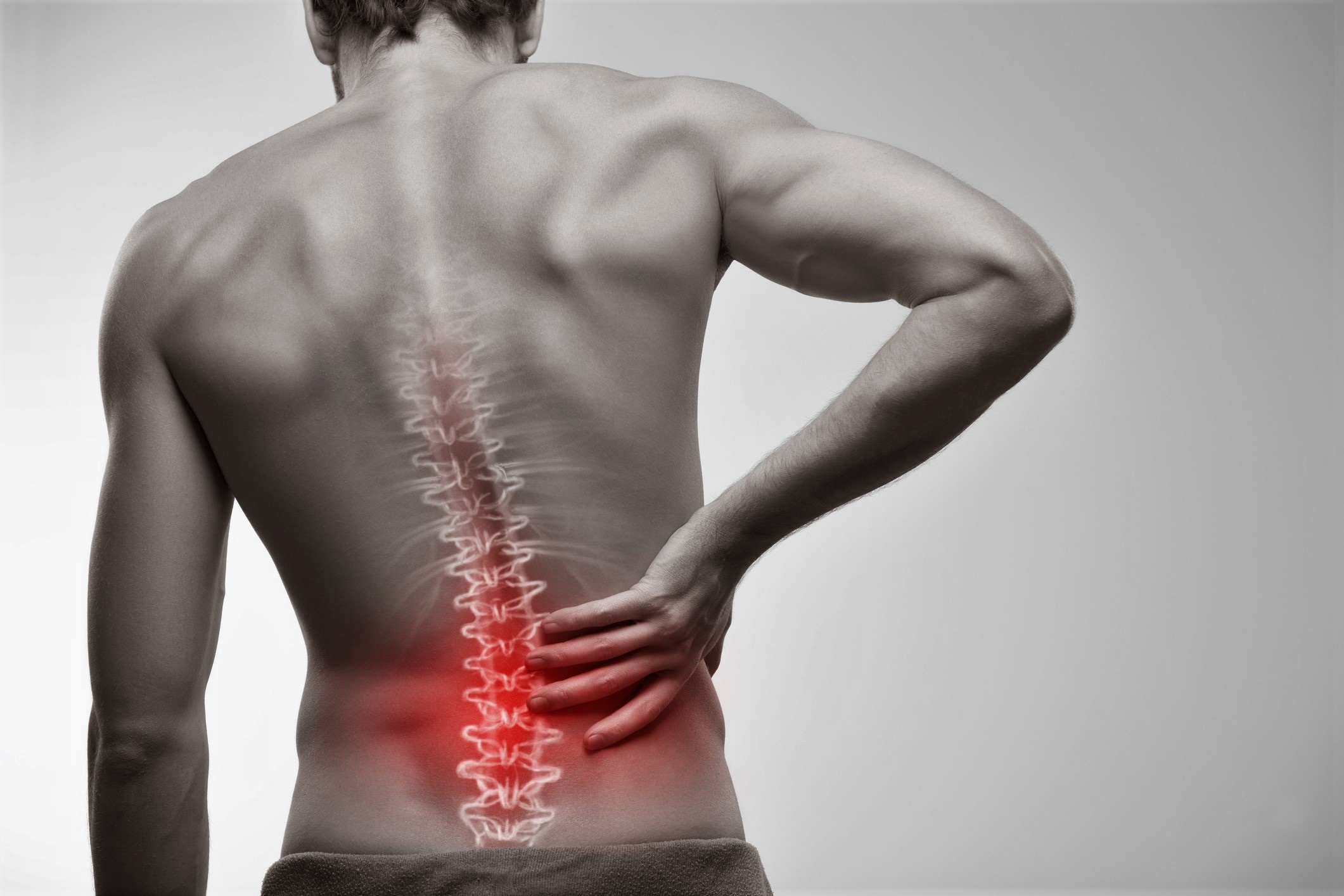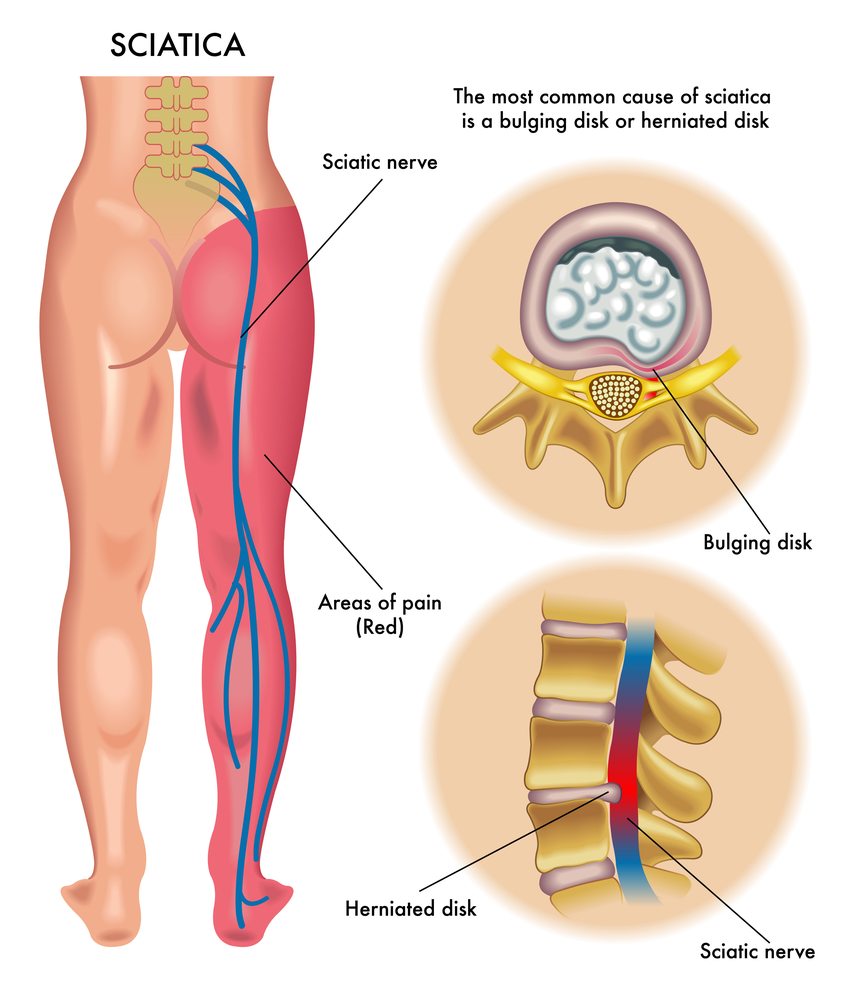Sciatica – Symptoms and causes
Sciatica Nerve Pain – Symptoms and causes – what causes sciatic nerve pain Sciatica Comprehensive overview covers symptoms, treatment of this acute back, pelvic and leg pain.
How to cure sciatica permanently
Sciatica Symptoms and causes – what causes sciatic nerve pain
Sciatica is a condition defined by pain radiating from your lower back to your hips and buttocks down your leg. Usually, people experiencing sciatica only feel it on one side of the body. A spinal disc herniation, which is characterized by a bone spur on the spine, or a weakening of the spine (spinal stenosis) compresses part of the nerve, causing sciatica. The affected leg is characterized by pain, discomfort, and numbness.
Despite the intensity of the pain, most patients will heal with non-operative treatments in a few weeks. Patients who suffer from chronic sciatica and have significant leg disability or bowel or bladder modification may be candidates for surgery due to sciatica symptoms once they determine the cause of sciatica.
Symptoms and Signs
A person with sciatica symptoms feels pain radiating from the lower (lumbar) spine to their buttock and down their body. There is no definite location where the pain occurs, but it will most likely be somewhere in your nerve pathway, it’s likely to occur along a line running from your low back to your buttocks, as well as along the back of your thigh and calf. Depending on the severity, the pain can be dull, intense, burning, or unbearable. Occasionally, it can feel like an electric shock or a jolt. Sitting for prolonged periods of time can exacerbate symptoms, as can coughing and sneezing. Affected sides are usually either the right or left. Affected legs or feet may also experience pain, tingling, or stiffness. It may feel like you are experiencing pain in one region of your leg while feeling numb in another those are typical sciatica symptoms.
When to see a doctor
Mild sciatica symptoms normally disappears over time. See your doctor if you’re experiencing pain that lasts more than a week, is severe or worsens over time, or if you generally do not feel better after self-care interventions. Whenever you experience any of the symptoms listed below, get medical attention as soon as possible.
The leg numbs or is stiff and you feel acute, intense pain in the low back or the leg.
Pain occurring after traumatic situations, like a car crash.
There’s no control over your bladder or bowels.
Causes
Sciatica is caused by a pinched sciatic nerve, which is normally caused by a spinal disc herniation on your back or a bone spur on one of your vertebrae. The nerve can be compressed by a tumor or affected by conditions such as diabetes.
Spinal stenosis, or narrowing of spaces in the spinal cord, can also be responsible for sciatica. When a nerve’s passageway is narrowed, the narrowing space may give off an irritating effect on the sciatic nerve root that could then cause Sciatica. Compression of the disks causes a narrowing of the nerve passageways (spinal stenosis). If the sciatic nerve roots are pinched by spinal stenosis, they can cause pain.
An injury to the nerve root caused by a herniated or slipped disk. Most sciatica cases are due to this condition. Each vertebra of the spine is cushioned by a disk. Herniation can occur when a weak spot in a disk’s outer wall allows pressure from vertebrae to cause it to bulge (herniate). The sciatic nerve is affected when a herniated disk presses against the vertebrae in the lower back.
Spondylolisthesis occurs when the vertebrae are misaligned with one another, resulting in a smaller gap from which nerves are exited. Extending the spinal column can make the sciatic nerve pinched.
Arthritis of the knee, which is called osteoarthritis. When a spine ages, bone spurs may form (jagged edges), which can compress the lower back nerves.
Sciatic nerve or lumbar spine trauma.
Compression of the sciatic nerve by tumors in the lumbar spinal canal.
A condition known as piriformis syndrome results from an overactive or spastic piriformis muscle, deep in the buttocks. Sciatic nerves can become irritated and put under pressure when this occurs. Neuromuscular disorders such as Piriformis syndrome are uncommon.
Risk factors
Numerous factors can contribute to sciatica and symptoms caused, such as:
Age is a factor. The most common cause of sciatica is age-related changes in the spine, such as herniated disks and bone spurs.
Obesity is an issue. Excess body weight will lead to spinal changes that cause sciatica by increasing the tension on your spine.
Occupation. People may be prone to sciatica if their occupation requires them to participate in activities that involve twisting their spines, lifting heavy weights, or driving long distances for long periods of time, although their connection to this condition is not established.
Long periods of sitting. It is more likely that sciatica will occur in someone who has a sedentary lifestyle or stays in the same place for extended periods of time.
Diabetes is a condition that affects millions of people all over the world. The way the body uses blood sugar is affected by this disease, which raises the risk of nerve damage.
Complications
Even though most people are able to recover completely from sciatica without surgery, it can permanently damage nerves. You should seek immediate medical attention if any of the above symptoms occur.
- The sensation is lost in the affected limb.
- Insufficiency of the infected leg
- Deficiency in bowel or bladder control
Diagnosis
An evaluation of your medical history will be performed by your healthcare provider. Afterward, you will need to describe your symptoms to your healthcare provider.
As part of your physical exam, your healthcare provider will ask you to walk to determine how your spine supports your weight. The strength of your calf muscles could be checked by having you walk on your toes and heels. It’s possible that your doctor will conduct a straight leg raise test as well. Your legs should be straight while lying on your back for this test. When you raise each leg slowly, your care providers will note the point where you feel pain.
Tests like these determine which nerves are affected as well as whether a disk has a problem. Further stretches and motions will also be asked so the doctor can pinpoint pain as well as test muscle flexibility and strength.
In some cases, imaging and other tests will be recommended by your healthcare provider after your physical exam. There are several possibilities here to find sciatica causes, including:
- Spinal X-rays: Taken to identify fractures, disk problems, infections, tumors, and bone spurs.
- Magnetic Resonance Imaging (MRI) or Computed Tomography (CT) scans: Computed tomography (CT) or magnetic resonance imaging (MRI) scans of the back may be used to view detailed images of bone and soft tissues related to the back. MRI can identify pressure on a nerve, arthritic conditions, disk herniation that may press on a nerve. An MRI is typically routinely ordered to confirm a diagnosis of sciatica.
- Nerve conduction velocity studies/electromyography: Studies of the conduction speed of the sciatic nerve and electromyography to examine how electrical impulses travel through the sciatic nerve and how muscle contractions are affected.
- Myelogram: A myelogram can be used to figure out if the pain stems from the vertebrae or disk.
Prevention
A person with sciatica may recur at any time, and the disorder is not necessarily preventable. Here are some tips that will help you secure your back:
Exercise on a daily basis. Make sure you pay attention to your core muscle, which represents these muscles in your abdomen and lower back that give you balance and coordination, to keep your back strong and prevent sciatica abdominal pain. For specific events, seek the advice of your doctor.
Be sure to sit with the right stance. Select a seat that swivels, has armrests, and provides a firm lower back support. You can keep your spine’s natural curve by placing a pillow or folded towel on your back. Ensure that your knees and hips are leveled.
Make full use of the body mechanics. Taking a break and resting one foot on a stool or a little box is a good idea if you must stay for an extended period. You need to let your legs do the lifting when you are lifting something heavy. Keep a straight line while going up and down. Strive to maintain a straight back and elbows bent just a little. Maintain close proximity to the body when carrying a load. It is not a good idea to lift and spin at the same time. Finding a lifting partner is helpful if the item is bulky or complicated.
Make use of an ice and heat pack. Remedies like alternate heat and ice therapy can give relief for sciatica nerve pain. Sciatica is frequently accompanied by painful muscle spasms, which may also be helped by alternately applying heat and ice. Once every hour, apply an ice pack to the painful area for 15 minutes, followed by 15 minutes of heat every two to three hours. You should always use a barrier to protect your skin from heat or ice (like a towel). When you apply ice to a painful area, it can reduce inflammation while applying heat stimulates blood flow to the area. The recovery process may be sped up this way.
Sciatica pain is caused by an irritation, inflammation, pinching or compression of a nerve in the lower back. The most common cause is a herniated or slipped disk that causes pressure on the nerve root. True sciatica is an injury or irritation to the sciatic nerve, which starts in your buttock/gluteal area. It can cause muscle weakness in your leg and foot, tingling pins-and-needles sensation. Sciatica is a very common complaint that often can be fixed with physical therapy.
About 40% of people in the U.S. experience sciatica sometime during their life. You are at greater risk if you have an injury to your lower back or spine. Your spine is like a vertical crane your muscles are the counterweights. The stronger your core, the more support you’ll have for your lower body and less low back pain. If you don’t follow proper posture in the weight room, you can be prone to sciatica causes.
Sciatica can be caused by a herniated or slipped disk that causes pressure on a nerve root. Ligaments hold the vertebrae together, protect the disks and keep the spine stable. The baby’s weight and position can also add pressure to the nerve. Physical therapy and massage therapy, warm showers, heat, pain medications and other measures can help. If you are pregnant, be sure to follow good posture techniques during pregnancy for treating sciatica and sciatica pain relief.
Piriformis syndrome is a condition that develops when the piriformis muscle, a small muscle that lies deep in the buttocks, becomes tight or spasms. The symptoms of sciatica include: Moderate to severe pain in lower back, buttock and down your leg. Straight leg raise test helps spot your point of pain. Cauda equina syndrome is rare but serious condition that affects the bundle of nerves at the end of the spinal cord. a sciatica can be treated with ice, heat, hot packs, stretching, over-the-counter medicines and exercise.
The type of pain can be different, the intensity of pain is different and the cause of the pain can also be different. If a six-week trial of conservative, self-care treatments has not provided relief, it’s time to return to a healthcare professional. An injection of a corticosteroid, an anti-inflammatory medicine, into the lower back might help reduce the pain and swelling around the affected nerve roots. Alternative therapies to improve sciatic pain include spine manipulation by a licensed chiropractor, yoga or acupuncture. Massage might help muscle spasms that often occur along with sciatica.
Most people recover fully from sciatica, but chronic pain can be a complication of the condition. Maintaining good posture helps relieve pressure on your lower back and reduces low back pain. Exercise regularly to keep your joints flexible and strengthen your core – the muscles that support your spine. Don’t smoke, exercise regularly and don’t sit for long periods of time. Most people with sciatica get better without surgery and about half of these recover fully within six weeks.
If your pain starts in the back and moves or radiates towards the hip or down the leg and you have numbness, tingling or weakness in the leg, it’s most likely to be “sciatica” Radiculopathy is a broader term that describes the symptoms caused by a pinched nerve in the spinal column. It can cause severe leg pain lasting more than a few hours that is unbearable. Some rest, bed rest, and change in your activities and activity level may be needed. a that is caused by a herniated disk, spinal stenosis, or bone spur that compresses the sciatic nerve can cause inflammation – or swelling – in the affected leg. Complications of piriformis syndrome can also cause swelling in the leg.
Are restless leg syndrome, multiple sclerosis, carpal tunnel syndrome, plantar fasciitis, shingles or bursitis related to sciatica? None of these conditions are directly related to Sciatica. Most cases of sciaticia do not require surgery. Time and self-care causes treatment are usually all that’s needed. However, if simple self care treatments do not relieve your pain, reducing pain, see your healthcare provider that sees patients with sciatica and are a health care professional.
What Causes Sciatic Nerve Pain?
Sciatic nerve pain is a common problem that many people experience at some point in their lives. The nervous system is a delicate part of human anatomy, and with a condition that causes severe pain, it’s difficult to appreciate the human body.
What causes it? Does sciatic nerve pain go away on its own? What can you do to relieve this type of back pain and discomfort?
Read on ahead to know more about it.
What is Sciatica? Symptoms Causes Diagnosis
Sciatica is a type of nerve pain that occurs in a person’s lower extremities. What does that mean?
Nerves are like cables, and sciatica is a condition where the collection of nerves in your spine are compressed, causing pain.
In simple terms, Sciatica is classified as nerve pain occurring in the sciatic nerve in a person’s legs.
A sciatic nerve problem can cause stabbing pain that radiates along the path of the nerve, which runs from your low back through each leg and up your hips. An individual suffering from sciatica often only feels it on one side of the body.
Generally, sciatica develops when a herniated disk, bone spur, or narrowing of the spine (spinal stenosis) is causing pressure on the nerve. Legs affected by this condition experience swelling, pain, and occasionally numbness.
Although sciatica can be painful, non-operative treatments usually resolve this condition within a few weeks. If sciatica causes muscle weakness or changes in bowel function or bladder function, surgery may be an option for people with severe sciatica.
Where Does Sciatica Pain Come From?
There is no one cause for this kind of nerve pain. There are many factors at play, and the sciatic nerve is often affected for it to involve pain in this region. The pain could be caused by a herniated disc pressing onto the nerve or by other factors like pelvic misalignment.
The most common cause for this type of nerve compression is a spinal disc herniation or pinched spinal cord.
Sciatica can be caused by many different things:
- Diseases or disorders such as arthritis or spinal stenosis
- Problems with intervertebral disc (the bones in the spine)
- Problems with the joints in a person’s back causing pressure on the spine, or problems with the spinal cord
- Diabetes: if blood sugar is too high for an extended period of time, this can lead to nerve damage.
The most common cause is from a lumbar herniated nucleus pulposus (a ruptured disk), which can put pressure on the nerves in your back and give you shooting pain down your leg.
Sciatica pain from a herniated disk may also be accompanied by paresthesia or the feeling of numbness, tingling, or burning sensation. It typically starts on one leg and extends to the other as it becomes more irritated. But most times, only one leg is heavily affected.
What’s more, there are many other ways you can end up with sciatica pain:
- If your spine has become misaligned due to an injury or disease like degenerative disc disease.
- It can also happen as the result of getting older because your body’s disks may shrink and start to wear out.
- Lumbar spinal stenosis: It happens when a person has arthritis, and it’s causing thickening of the discs, which leads to narrowing around your nerve roots.
- Piriformis Syndrome: The piriformis muscle is located deep within the buttocks. It runs directly over the sciatic nerve and joins the lower spine with the thigh bone. When this muscle spasms, it puts pressure on the sciatic nerve, resulting in sciatica symptoms. Piriformis syndrome affects more women than men.
Sciatica symptoms and treatments depend on what exactly has caused sciatica to occur. If it turns out that your sciatica nerve pain is caused by other issues like a herniated disc or pinched spinal nerve roots, and it doesn’t get better after applying home remedies, a doctor, orthopaedic surgeons specifically, may recommend surgery.
Several common factors may affect the sciatic nerve:
Mechanical Nerve Compression: Direct physical forces may be applied to the nerve due to the following common conditions:
Herniated Discs: The lumbar spine can be affected by a herniated or bulging disc that compresses the sciatic nerve.
Foraminal Stenosis: Compression or irritation of the sciatic nerve may result from narrowing of the vertebral column or from contracting the roots of the sciatic nerve. Degenerative changes in the spine may directly compress the sciatic nerve when thickened ligaments and/or capsules within the facet joint.
Segmental Instability: In certain conditions, such as when a vertebra slides on top of another (spondylolisthesis), when there are vertebral defects (spondylolysis), or when one or more bones dislocate, the sciatic nerve root(s) are directly compressed.
Tumors, Cysts, Infection, & Abscesses: The sciatic nerve can be compressed by tumors, cysts, infections, or abscesses affecting the lower spine or pelvis in rare instances
Chemical Inflammation: The sciatic nerve may experience inflammation and/or irritation due to chemical irritants. Degenerate or herniated discs may cause nerve tissues to grow into the disc and penetrate the outer and inner layers, causing sciatica pain. These irritants may also be caused by acids such as hyaluronic acid and proteins such as fibronectin (proteins).
Immune Response: Herniated discs that expose disc material may cause sciatica pain because of immune responses. Those with sciatica tend to produce a lot of substances produced by the immune system, including glycosphingolipids (fats) and neurofilaments (protein polymers). This inflammation is believed to result from chemicals released between the nerve roots and exposed disc material in response to irritation.
Physical Characteristics: The sciatic nerve may be affected by certain physical characteristics of an individual. Sciatica is more likely to be seen in people who:
- Obese or overweight individuals
- Elderly people who have large stature (typically over 180 cm for men and 170 cm for women)
Work-Related Causes: Sciatica pain is more common among people with certain occupations—for example, truck drivers, machine workers, woodworkers, and weight-lifting athletes. Generally, sciatica occurs when the spine is exposed to prolonged sitting without proper posture when the upper arms are often raised above shoulder level, and/or when the spine is frequently bent forward or sideways.
Nutritional Deficiency in Vitamin B12: Maintaining nerve health requires adequate vitamin B12 intake. The B12 vitamin plays an important role in synthesizing the fatty sheath (myelin) that surrounds nerves. This is important for nerve function and the conduction of nerve impulses. Those who are older than 60 and who are deficient in vitamin B12 may develop sciatica. Metabolic malabsorption may additionally cause vitamin B12 deficiencies in people with diabetes who take metformin.
What Causes a Herniated Disk in Your Spine?
Herniated discs usually occur when there’s too much pressure on the disc from the inside.
What Causes Spinal Stenosis?
It happens when the space around the nerve root narrows and puts pressure on it. This is a common occurrence among people who have arthritis or a back injury.
Treatment
What you do depends on what’s causing your sciatic nerve pain. If it turns out that you have a herniated disc in your spine, there are several different types of treatments. Consult professional medical advice or seek medical attention to prevent sciatica from getting worse, which could lead to permanent nerve damage.
For acute sciatica and chronic sciatica, consider these health solutions:
Medicine: Sciatica can be temporarily relieved with over-the-counter pain relievers. In addition to acetaminophen, nonsteroidal anti-inflammatory drugs (NSAIDs) such as aspirin, ibuprofen, and naproxen are available. To further reduce inflammation, your doctor may administer an injection of steroids.
Physical Therapy or Stretching: Maintain an active lifestyle while your sciatica is healing. Pain and inflammation can be reduced through movement. Learn how to stretch the hamstrings and lower back gently with the help of a physical therapist. You can strengthen your core and stabilize the affected area by practicing Tai Chi or Yoga. In some cases, you may not be able to do certain exercises due to your medical condition. You may also be advised to take short walks by your doctor.
Surgery: After four to six weeks, if you are still suffering from severe sciatica pain due to a herniated disk, surgery may be an option. Surgery is performed to relieve pressure on the sciatic nerve by removing a portion of the herniated disk. In about 90% of cases, this type of surgery relieves the patient’s pain. Sciatica due to spinal stenosis can be treated with other surgical procedures.
Preventing Sciatica
It is possible to get sciatica again after having it once. You can lower the odds by taking the following steps:
- Keep active.
- Take care of your posture.
- If you are lifting heavy objects, bend your knees.
What is sciatica?
Sciatica in Wikipedia
Sciatica is pain going down the leg from the lower back.[1] This pain may go down the back, outside, or front of the leg.[3] Onset is often sudden following activities like heavy lifting, though gradual onset may also occur.[5] The pain is often described as shooting.[1] Typically, symptoms are only on one side of the body.[3] Certain causes, however, may result in pain on both sides.[3] Lower back pain is sometimes present.[3] Weakness or numbness may occur in various parts of the affected leg and foot.[3]
Low back pain (LBP) or lumbago is a common disorder involving the muscles, nerves, and bones of the back,[4] in between the lower edge of the ribs and the lower fold of the buttocks. Pain can vary from a dull constant ache to a sudden sharp feeling.[4] Low back pain may be classified by duration as acute (pain lasting less than 6 weeks), sub-chronic (6 to 12 weeks), or chronic (more than 12 weeks).[3] The condition may be further classified by the underlying cause as either mechanical, non-mechanical, or referred pain.[5] The symptoms of low back pain usually improve within a few weeks from the time they start, with 40–90% of people recovered by six weeks.[2]
Sciatica in Wikidata
medical condition with pain down the leg from the lower back sciatic neuralgiaBilateral SciaticaNeuralgia, SciaticNeuralgias, SciaticBilateral SciaticasSciatica, BilateralSciatic Neuralgias
Sciatica in Google
The sciatic nerves branches from your lower back through your hips and buttocks and down each leg. Sciatica refers to pain that radiates along the path of the sciatic nerve, which branches from your lower back through your hips and buttocks and down each leg.























